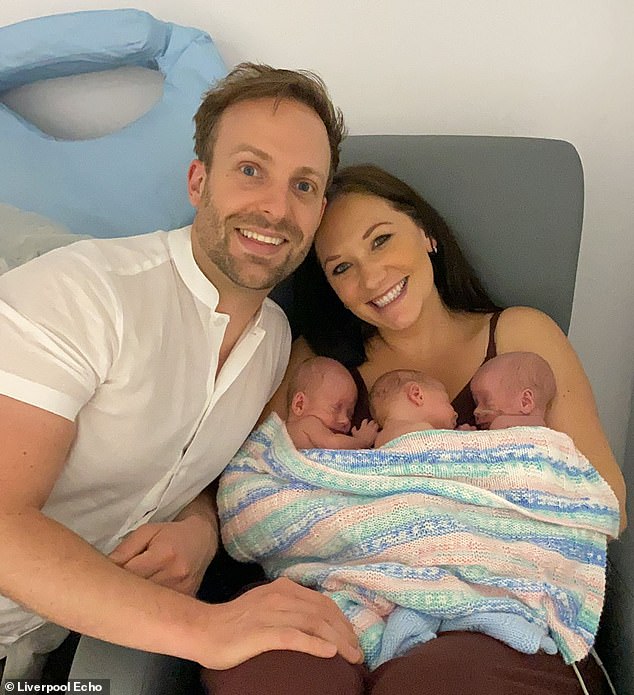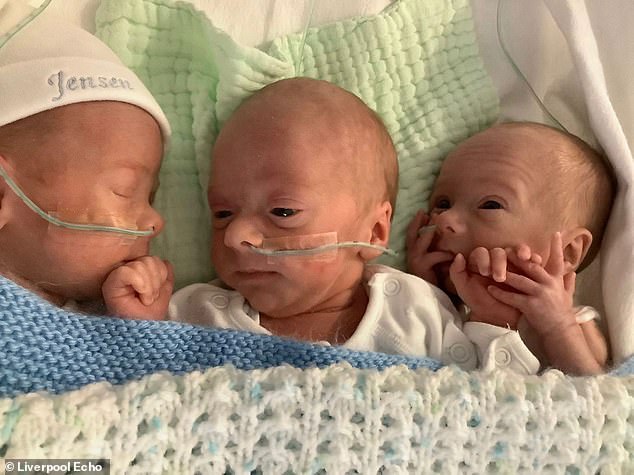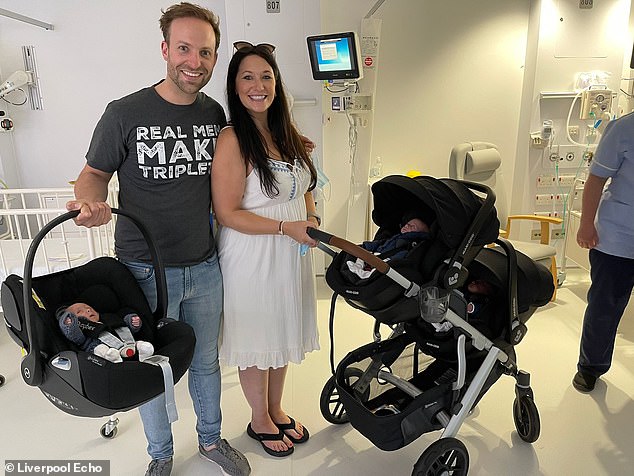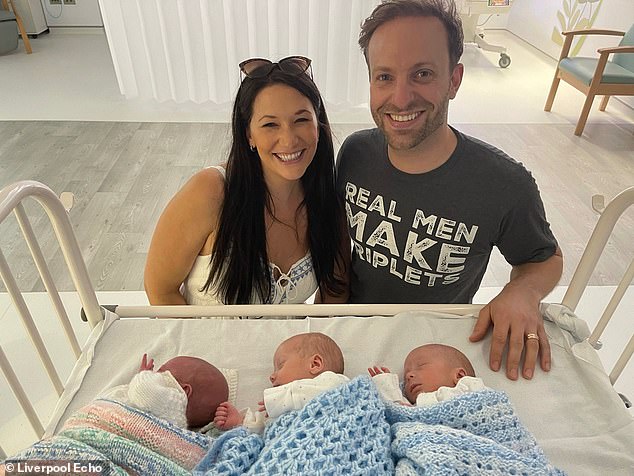A mother has given birth to a ‘one in 200million’ set of identical triplets who shared the same placenta.
The three boys — Jimmy, Jensen and Jaxson — were born a month early at Liverpool Women’s Hospital on April 26.
The trio were delivered via C-section within seconds of each other to parents Gina and Craig Dewdney.
The couple, from Cheshire, was shocked to learn at a 13-week ultrasound that they weren’t just expecting their first child — but first three.
Mrs Dewdney, 34, revealed 30 medics were in the delivery room because each baby had to have its own neonatal team.
Her pregnancy was deemed ‘high risk’ because the youngsters were found to be sharing the same placenta.
Children born this way are more likely to face issues because the nutrients and food from the mother has to be split three ways.
Most triplets are conceived through IVF and doctors estimate the odds of having three identical children naturally is as low as one-in-200million. And the chance of all three babies sharing a placenta is even smaller.

Jimmy, Jensen and Jaxson were born a month early at Liverpool Women’s Hospital on April 26. The trio were born via C-section within seconds of each other to parents Gina and Craig Dewdney, from Cheshire

Mrs Dwedney, 34, revealed 30 medics were in the delivery room because each baby had to have its own neonatal team

The pregnancy was deemed ‘high risk’ because the youngsters were found to be sharing the same placenta
What makes the trio even more unique is the fact Jaxson had his own amniotic sac, a thin-wall of plasma that surrounds the foetus during pregnancy.
They are what is known medically as monochorionic diamniotic triplets, where three babies share one placenta but one of them has their own amniotic sac.
Jimmy, Jensen and Jaxson were born in exactly one minute and 52 seconds from the ‘time the knife went in’.
The babies, who are now five-months-old, spent six weeks in the neonatal intensive care unit but have since come home and are returning for regular check-ups.
Mrs Dewdney said breastfeeding and lack of sleep has proven difficult, but the babies have started to develop individual personalities.
She said: ‘They’re starting to smile now and starting to see their characters.
‘What is interesting is they are all identical and DNA is the same, but they’ve got such different personalities already.
‘I think that is fascinating because they are all being brought up the same and you think of nature versus nurture.’
The mother revealed she fell pregnant within just a few weeks of trying last autumn and ‘had this feeling’ that she was going to have more than one baby.
‘I had it in my head that it would take me a long time to get pregnant because it usually does take people a couple of years trying,’ she said.
‘We thought let’s see what happens and within a month I fell pregnant.
‘I found out very early that I was pregnant, within a few weeks, and I started getting really severe migraines, which I don’t usually suffer from.
‘But I was having visual migraines, really bad headaches and insomnia – I just couldn’t sleep and kept waking up in the middle of the night wide awake.
‘I had this feeling that there was more than one baby and I had feeling we were having twins.

The now five-month-old babies spent six weeks in the neonatal intensive care unit but have since come home and are returning for regular check-ups
HOW RARE ARE IDENTICAL TRIPLETS?
There isn’t one, consistent statistic quoted when it comes to the odds of having identical triplets.
Instead, doctors say it is in the vicinity of between one in 60,000 to one in 200million, depending on how the children are conceived.
Triplets are much more common when a woman becomes pregnant through IVF, for example.
It’s thought that just one in 10,000 triplet births are the result of spontaneous conception.
Identical triplets are always of the same sex.
They occur when a single egg is fertilised by a single sperm.
That egg then splits up, for reasons not quite understood yet, forming multiple, identical embryos that continue to grow independently.
The majority of triplets are what is known as trizygotic.
This is because they are formed when three separate, individual eggs are fertilised by three separate sperm.
These babies share the same characteristics as any other siblings with the same biological parents. They can be the same or opposite genders.
Advertisement
‘I said it to my husband but didn’t mention it to anyone else and I didn’t really tell anyone I was pregnant because we weren’t seeing anyone in lockdown and I thought I would wait until the first scan and be traditional in that respect.’
Mrs Dewdney added: ‘Our first scan wasn’t until 13 weeks and we went to the Liverpool Women’s and straight away the woman put the ultrasound on said it was twins.
‘And because I already told Craig and I had it in my head, it was a bit of shock because one thing having a feeling about it and then being told it was real.
‘But 15 to 20 minutes into the scan she was scanning round my stomach and it went deadly quiet in the room and all you could see on the screen was three heads.
‘My husband asked, “Is that a third head?”’
Consultants said it appeared that Ms Dewdney was expecting three identical boys and that they were all sharing the same placenta.
A pregnancy of this type could be more likely to encounter problems such as preeclampsia or transfusion syndrome, when their blood vessels become conjoined.
Other complications of which to be aware are gestational diabetes and foetal growth restriction.
However, at 16 weeks there seemed to be a mix-up with the sex of the babies and the couple were told they were expecting two girls and a boy.
The dental therapist added: ‘At 16 weeks I was told it looked like two girls and one boy and two placentas fused together, but doctors couldn’t see where it had been fused. I was like “oh good get a bit of both”.’
Ms Dewdney said she bought clothes for the two girls and the boy, named them and ‘envisioned’ what life would be like with them.
However, at her 24-week scan the couple were told that in fact it definitely was three identical boys and it was difficult during ultrasounds to get a clear view as ‘someone’s foot would get in the way or someone’s head or they would kick each other’.
Doctors had planned for Ms Dewdney to have a c-section, however her waters broke at 34 weeks and she started to have contractions and was rushed for an emergency C-section.
Source link : https://www.dailymail.co.uk/news/article-10037313/British-mother-gives-birth-200million-one-set-identical-triplets.html











